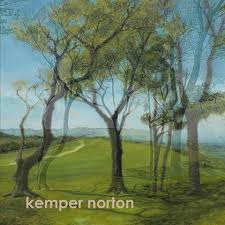The music of Kemper Norton streaks across the ages like a tipsy beach-comber, enthusiastically and expertly skipping across time’s tide and handpicking an array of instruments, contexts and influences to form what he succinctly describes as "coastal slurtronic folk". Far from being a romantic nostalgia trip, like the rash of recent releases that turn today’s laptops into yesteryear’s Radiophonic Workshop to relive their youths spent watching cult TV, Kemper Norton’s music exists within the continuum, encapsulating a free range of sounds and stories spread throughout history. Here, medieval mandolins meet modular synths, or a 19th century harmonium harmonises with its future cousin the Casio keyboard, evoking anything from pre-Christian myth to post-modern polemics.
Carn, his debut physically released album, draws together two conceptually related download-only EPs from 2012-13. Like many of the other download-only releases he has intermittently skimmed surreptitiously across the internet (most of which are no longer available) – both ‘chapters’ of Carn are firmly and personally linked to a specific place: Carn 1 marks the end of Kemper Norton’s life in Cornwall by focussing on Carn Euny fogou, an astronomically-aligned Iron Age chamber in West Penrith where he spent the eclipse of 1999; while Carn 2 is located in his new home of Sussex and centred on Chanctonbury Ring, also Iron Age in origin. Both locations bear ‘uncanny’ contexts, the primary quality sought by Kemper Norton’s sound.
Aptly, a backwards-camouflaged voice opens the Cornwall side, stating "some kind of ritual significance", barely perceptible amidst woozier, time-stretched voices orbiting shiny moons of mandolin and starbursts of computer glitchery. As with the five tracks that follow, much of its ingredients were recorded within the mysterious fogou itself, whose ancient function was thought to be ceremonial. In doing so, Kemper Norton is wholly in sympathy with its use, extending its original purpose by some 2,000 years and trapping its mysterious aura on disc. These ‘field recordings’ are more to do with process than finish, but add a sense of live performance in real time to an otherwise virtual, studio-layered composition.
The moody atmospheres divert briefly on ‘Colour The Ocean Pink’, which refers to a legend from the St Agnes region in which a woman tricks a tyrannical giant into filling a hilltop hole with his blood in exchange for her hand in marriage. Being ignorant to the hole’s opposite end opening out on the sea, the determined giant dies from blood loss. Despite the gory details of lore, Kemper Norton’s commemorative music is that of a celebration, with uptempo loops of festive hand drumming guiding a carnival of plucked tones, wildlife recordings and violins, all blurring together as if each is travelling on the air from separate, bordering fields.
The standout track from Carn‘s first part is ‘Dorcus’, named after the woman thought to haunt Polbreen Mines after committing suicide there. Its distinctiveness is down to it being a version of a traditional folk song (Died For Love’, made famous by Shirley Collins in 1960) where, instead of the cool confusion of acoustic, analogue, and digital vibes found elsewhere, we get a stripped back scene of harmonium, water ambience and voice. Mashed-up with its haunting context, it transforms the dour folk song into a sad hymn – Kemper Norton’s charmingly unaffected voice sounding a little like Syd Barrett’s own idiosyncratic folk song.
The Sussex ‘side’ largely stays in one place – a ring of trees atop Chanctonbury Hill on the South Downs – where it is said the devil is raised if you circle the trees seven times, anti-clockwise. Once again, many of the sounds across its six tracks were recorded in situ to draw the location’s essence into the music. Indeed, ‘Seven Times Round’ uses crowd-sourced vocals counting unsteadily to the fabled seven in various languages including Cornish. Like the rest of the album, the sum effect has a kind of dream logic not dissimilar to that of fellow Cornishman Aphex Twin’s Selected Ambient Works Volume II – fragments of voice, traces of rave and all kinds of unidentified flying audio seduce the listener into forming their own chimerical conspiracies.
However, Carn need not be listened to with one eye on the sleeve notes and the other on Wikipedia to successfully interpret its multilayered musings. Although tales of giants, ghosts, devils, dragons and fairies have all helped to form the music on this album, like they did on preposterous prog excursions before them, the sound of Carn is not so much about its excavated source material, but about living in the modern world while acknowledging the presence of folklore and what is still left unexplained. Which makes the music’s deft blend of traditional songcraft with experimental electronics both accessible and potent enough to inspire its own mythologies. It is hard to predict what future communities will make of today’s social media practices and what new myths they will have inspired; in the meantime, Carn is helping to repair the damaged continuum that links us with our heritage, blurring the lines between the past and the present, between fact and fiction, to bring a greater focus on "the uncanny in the everyday".


